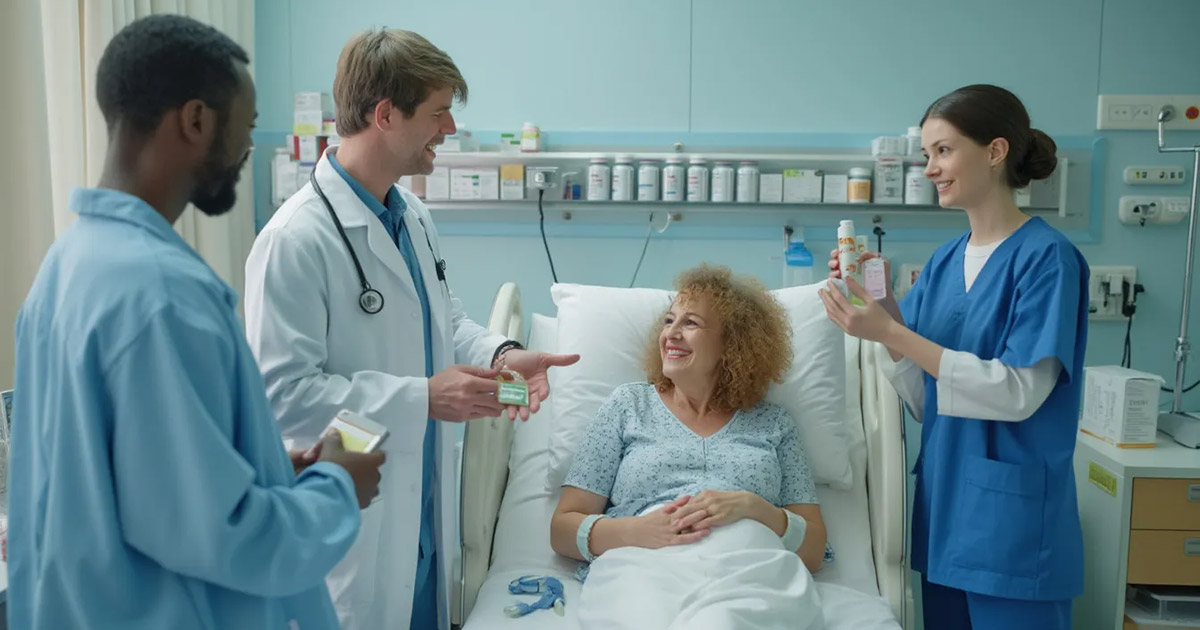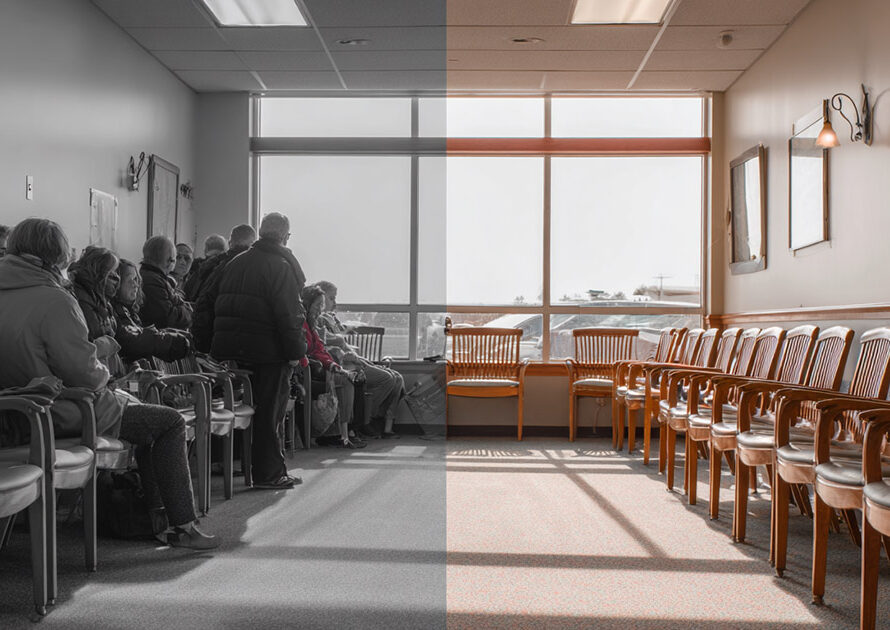Table of Contents
A summary of insights from a recent healthcare panel featuring our CEO, Monique Lappas, at NAHAM 2025.
The rising cost of healthcare has created an unprecedented financial burden for patients, even those with insurance. Deductibles and out-of-pocket expenses continue to climb and hospitals are challenged with collecting patient payments while maintaining their commitment to health equity and patient care.
Recently, our CEO, Monique Lappas, led a panel discussion alongside Story Bear, Patient Financial Advocacy Manager at Baptist Health, to address these critical issues and share solutions at NAHAM 2025.
The Growing Problem of Financial Toxicity in Healthcare
Financial toxicity, the detrimental impact of healthcare costs on patients’ financial wellbeing, has become a significant barrier to care. According to data shared during the panel, insured patients with bad debt have increased dramatically from approximately 12% in 2016 to nearly 60% by 2022. This striking statistic highlights that even patients with insurance coverage are struggling to pay their medical bills.
The root cause? Rising deductibles and patient cost sharing. As employers and individuals seek more affordable premium options, they often select plans with higher deductibles. When a medical emergency or serious diagnosis occurs, patients face thousands in out-of-pocket expenses they simply cannot afford.
Monique illustrated this challenge with a concrete example:
I provide health insurance to my employees. I try to do the right thing. I have a fully covered health plan. But the one I can afford as an employer leaves my employees with an $8,500 deductible.
The Real Impact on Patients
I'm in tears. Thank you so much for this wonderful news... This is a true miracle to me... Thank you seems so inadequate, but I thank them from the bottom of my heart.
This emotional response demonstrates how financial assistance programs deliver more than just monetary relief, they provide hope and dignity to patients facing difficult circumstances.
Even more concerning is that financial fears are causing patients to delay or forego necessary medical care. The panel highlighted that approximately 40% of Black women with breast cancer either delay or abandon treatment entirely due to their fear of medical debt. This statistic represents not just a financial problem but a profound health equity crisis.

The Financial Advocacy Ecosystem
Addressing financial toxicity requires a comprehensive approach. During the panel, Monique Lappas presented the financial advocacy ecosystem, which includes several key components:
- Medicaid Eligibility – Ensure eligible patients are enrolled in Medicaid programs
- Non-Traditional Funding Sources – Connect patients with external philanthropic funding to cover out-of-pocket expenses
- Hospital Financial Assistance Programs – Provide in-house charity care programs
- Payment Plans – Offer no-interest extended payment options
- Early Collection Efforts – Capture self-pay accounts early to prevent bad debt
Untapped Funding Sources for Patient Assistance
1. Foundation Programs
These disease-based and income-based programs can provide substantial financial support. They can retroactively cover expenses up to six months or even back to the beginning of the year. But, as Story Bear pointed out, foundation funds can open and close rapidly, sometimes within minutes, creating a “stop, drop, and enroll” situation where quick action is essential.
During the panel, Monique shared a timely example:
On my plane ride here yesterday, we just got an email from a client that said this patient's coming in, they're Medicare Advantage, they can't afford their $11,000 deductible. Thankfully, the Assistance Fund just opened a program within ten minutes of getting that email, saying that all patients with non-small cell lung cancer, doesn't matter what kind of insurance they have, the foundation is open.
2. Copay Cards
- Have easy enrollment through online portals
- Can sometimes cover costs retroactively up to 365 days
- Don’t have income requirements
- Allow hospitals to recover money from historical balances, reverse charity charges, and reclaim funds from debt collections
3. Patient Assistance Programs (Free Drug Programs)
Free drug programs are particularly valuable for:
- Self-pay patients
- Undocumented patients
- Cases requiring off-label prescriptions that insurance won’t cover
4. Specialty Programs
- Medical devices like pacemakers and stents for uninsured patients
- Specialized nutrition products like Ensure for patients with feeding tubes
- Other medical necessities that patients couldn’t otherwise afford

Implementation Challenges and Solutions
Successfully implementing a financial advocacy program requires addressing several key challenges:
1. Limited Patient Advocacy Resources
Most hospitals face constraints on hiring additional staff. Financial advocates juggle multiple responsibilities making it difficult to monitor foundation openings and complete time-sensitive applications.
Baptist Health’s experience illustrated this challenge. Their patient advocates couldn’t interrupt patient meetings to complete time-sensitive foundation applications when funds opened suddenly. This administrative burden prevented them from maximizing enrollment opportunities.
2. Health Equity Considerations
Hospitals have limited resources and yet are faced with increasing pressure to address social determinants of health and improve health equity.
3. Complex Workflows and Communication Gaps
- Automated Matching – Using technology to identify which patients qualify for which programs
- Case Trackers and Billing Indicators – Creating a systematic workflow to track patients and prevent premature billing
- Patient Consent in General Forms – Including permission language in standard consent forms, which increased collections by approximately 40%
We created our workflow using cases of trackers, analyzing our billing indicators. So when a patient is identified, we're opening the case in a tracker in our financial assistance module. And that tracker is program specific.
The Results: Financial and Human Impact
The partnership between Baptist Health and Qualify Health demonstrated remarkable outcomes:
Approximately $1 million secured through copay cards
- Another $1 million obtained through foundation programs
- Around 1,500 patients helped with their medical expenses
- Significant portion of assistance applied retroactively to existing balances
- Reduced bad debt and improved patient satisfaction
The data showed interesting seasonal patterns. Higher assistance needs win March and April when patients face new deductibles from January and February visits. This intelligence helps hospitals better allocate resources throughout the year.
Beyond the financial metrics, the program delivered profound emotional benefits for patients. As one patient expressed:
Thank you so much for this message. This is wonderful news. I appreciate all that you and Baptist have done for me and my health. Receiving this email has taken a significant financial burden of stress off my family. And for that, we are eternally grateful.
Addressing Broader Health Equity Needs
- Insurance Premium Assistance – Helping patients maintain coverage through programs that cover COBRA payments
- Transportation Assistance – Providing gas cards and transportation support to ensure patients can access care
- Urgent Needs Assistance – Offering help with utility bills and other essential expenses
A young boy, he's four, had a disease called Pompe. He had Medicaid. He was billed for very little. However, his parents had a fixed income of about $35,000 a year. They had to drive an hour every fourth Friday to get this little boy's infusion.
Through the PAN Foundation, the family now receives a gas card every six months, ensuring they can continue to bring their son for his life-saving treatments.
The panel also compared states with and without Medicaid expansion. They noted the profound difference in patient financial wellbeing between similar demographic populations in Louisiana (expanded) versus Mississippi (not expanded).
A Win-Win-Win Solution
Financial toxicity in healthcare represents a growing crisis affecting patients, providers, and healthcare systems alike. By implementing comprehensive financial advocacy programs that leverage external funding sources, hospitals can:
- Improve patient access to care
- Reduce the financial burden on vulnerable populations
- Advance health equity initiatives
- Decrease bad debt and improve revenue recovery
As healthcare costs continue to rise, these programs offer a path forward that benefits everyone involved, a true win-win-win solution that aligns financial objectives with the mission of providing equitable, accessible care to all patients.
Learn more about how Qualify Health can help your organization implement these solutions with no upfront fees or IT overhead.




